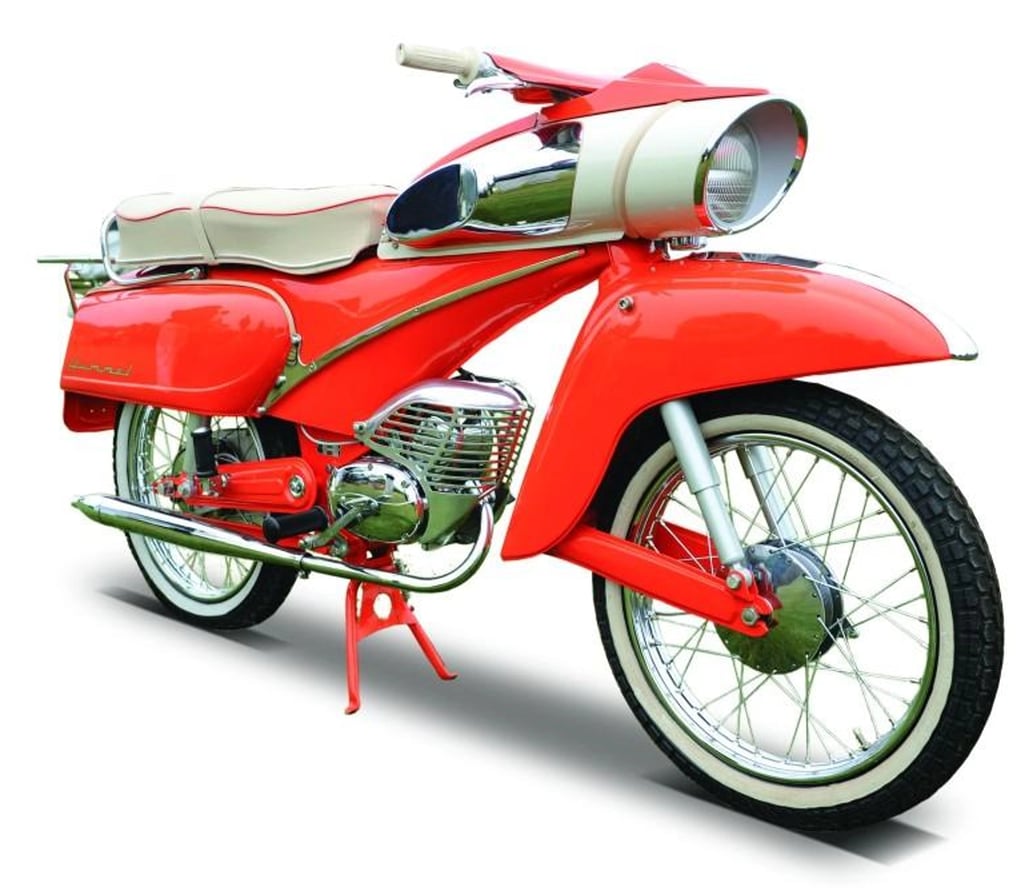DKW Hummel 155: Avant-Garde Aesthetics on Two Wheels
The 1965 DKW Hummel 155 was a revolutionary moped that stood out with its unique design and impressive performance. With a compact 50 cc engine, it reached a top speed of 45 mph, defying the norms of traditional motorcycle design. The Hummel 155 was part of DKW's legacy of innovative motorcycles and played a crucial role in propelling the evolution of mopeds. It perfectly reflected the cultural and historical context of the 1960s, aligning with the era's taste for distinctiveness and change.
MOPEDSVINTAGE MOPEDS1960'STWO STROKEGERMANY DKW
11/4/20233 min read


1965 DKW Hummel 155 - A Radical Moped Icon of the 1960s
Introduction
The 1965 DKW Hummel 155 was a product of German ingenuity that rode onto the scene leaving an indelible streak in the canvas of motorcycle history. This two-wheeler, with its unusual design and impressive performance, was fondly christened by the European motoring press as the 'Tin Banana'. The company behind this striking model, DKW, is an acronym for 'Das Kleine Wunder', translated as 'the little wonder'. Conceived in 1919, DKW was a brainchild of Danish engineer Jørgen Skafte Rasmussen, known for manufacturing steam fittings. Yet it was the advent of a two-stroke toy engine, aptly named 'Des Knaben Wunsch' or 'the boy's wish', that led to the combustion of a thrilling ride through motorcycle evolution, propelling DKW into the limelight.
The Birth and Evolution of the DKW Hummel 155
The DKW Hummel 155 symbolized a radical departure from traditional motorcycle design when it was unveiled to the public in 1965. At a time when the company was already a part of the prestigious Auto Union conglomerate, the Hummel 155 stood out with its bold aesthetics and innovative technology. DKW started its journey by producing motorized cycles in 1919, primarily with engines of at least 98 ccs displacement but always with two-stroke designs. The Hummel, however, broke this mold with a 50 cc engine. It was not just the compact size of the engine that distinguished the Hummel, but also its impressive performance. With 4.2 horsepower, the 155 quickly became notorious for cruising at 45 mph, despite its compact engine size. This motorcycle was indeed a 'Tin Banana' that refused to bend to the orthodoxies of design and performance.
Technical Specifications
The technical specifications of the DKW Hummel 155 were impressive for its time. It housed a single-cylinder, two-stroke engine with a displacement of 50 ccm. The engine utilized a Bing carburetor intake system, which was considered innovative at the time. The Hummel 155 had a top speed of 72.4 km/h (roughly 45.0 mph), phenomenal for a bike of its size and power. The machine was geared with a three-speed transmission, an uncommon feature for motorcycles of the same era. The motorcycle proved its versatility with an expansive drum brake system both in the front and rear. The chassis featured a link front suspension with coil-over shocks and a rear suspension utilizing a swing arm. Despite its compact size, the Hummel 155 was well-equipped with features normally found on larger, more traditional motorcycles.
The DKW Legacy and Hummel's Place in it
DKW, often referred to as 'the little wonder', has a legendary lineage of motorcycles. The revolutionary spirit of the company's founder, Rasmussen, was instrumental in establishing DKW as the world's largest motorcycle manufacturer by the late 1920s. The Hummel 155 has a significant position in DKW's illustrious lineage. Its unconventional design, compact yet powerful performance, and innovative features left an enduring mark on the industry. The Hummel 155 is not just a product of DKW's imaginative engineering, but also a symbol of the company's daring approach to design and a testament to its dynamic evolution.
Variations of the Hummel 155
The Hummel 155 was not a sole innovation but a part of a series that continued to evolve and reshape the moped landscape. Even after its introduction, the unique aesthetics and mechanical design of the Hummel 155 continued to inspire new models and variations. Each subsequent version carried the original's DNA while adding a touch of innovation and refinement. These variations of the Hummel 155, part of the dynamic legacy of DKW, played a crucial role in propelling the evolution of mopeds. They created new opportunities for motorcycle design while setting higher benchmarks for performance and style.
The Cultural and Historical Context of the 1960s
The decade of the 1960s was a vibrant and transformative period in history, marked by revolutionary changes in the socio-cultural landscape. Mod fashion, rock and roll, and freedom of expression were making headlines, and life on two wheels was not an exception. The advent of the Hummel 155 occurred in an era when the landscape of two-wheeled transportation was undergoing major reformation. This moped with its avant-garde aesthetics perfectly fit into the larger framework of the 1960s, mirroring the era’s taste for distinctiveness and an appetite for change. Simultaneously, it satisfied the demands of riders for a ride that was trendy, reliable, and carried a bit of audacity. Aligning with its time, Hummel 155 was the two-wheeled reflection of the fashion, music, and the cultural upheavals of the 60s.
